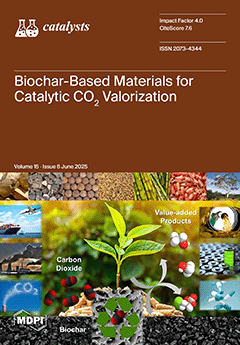This study investigated the remediation of organic acid pollutants, specifically butyric acid (C
4H
8O) and valeric acid (C
5H
10O
2), as well as their binary mixtures in the vapor phase at various ratios. The remediation process involved the use of a continuous pilot-scale reactor. A TiO
2 catalyst was deposited on glass fiber tissue (GFT) and ultraviolet (UV) irradiation with an intensity of 20 W/m
2. The main objective of this study was to assess the effectiveness of the photocatalytic process by oxidizing and mineralizing a mixture of carboxylic acids in a rectangular reactor at pilot scale. This was achieved by calculating the removal efficiency and the selectivity of CO
2 (S
CO2). Each individual compound was treated separately, followed by the treatment of binary mixtures with molar fractions of 0.25, 0.5, and 0.75. The concentration of pollutants at the inlet varied between 50, 100, 150, and 200 mg/m
3, while the flowrate ranged from 2 to 6 m
3/h. The obtained results for the removal efficiency of butyric acid, the binary acid mixture (25% butyric acid + 75% valeric acid), and valeric acid were satisfactory, with percentages of 58%, 32%, and 41%, respectively. It is evident that the selectivity toward CO
2 is better for butyric acid compared to valeric acid and the binary carboxylic acid mixture, with values of 43.70%, 33.49%, and 21.96%, respectively, across all concentrations. A simulation model based on mass transfer and catalytic oxidation mechanisms was developed and successfully validated against the experimental data for each pollutant. Reusability tests conducted on the TiO
2 on GFT, both in its initial (clean) state and after 50 h of the photocatalytic treatment of butyric acid, showed a 15% decrease in photocatalytic efficiency.
Full article





